You are using an out of date browser. It may not display this or other websites correctly.
You should upgrade or use an alternative browser.
You should upgrade or use an alternative browser.
Reviews by Bret Halford
Filters
Show only:
Loading…
Bret Halford
500+ Head-Fier
Pros: Bass. Bass. Bass. These aren't a cannon, they're as a ballistic bass warhead!
Subdued upper mids / lower treble minimizes technical requirements for the drivers
Subdued upper mids / lower treble minimizes technical requirements for the drivers
Cons: Overly expressed upper treble from the hypertweeter not great for some recordings / taste.
FATfreq Scarlet Mini
I have had some ear time with the new FATfreq Scarlet Mini now and my ears are starting to wrap around just how much bass this thing is injecting skullside. At least, when they are not cowering in fear.
This review will take the form of some brief initial impressions of the IEM and accessories, and then two parts of comparisons. First off, we'll compare the new Scarlet Mini to its blue bro, the Maestro Mini and then to its tribrid siblings the Maestro SE and Grand Maestro. There's also a bonus basshead comparison at the end, so be sure to scroll all the way through

In the world of IEMs and headphones, there are "all rounder" tunings and "specialist" tunings. The Scarlet is undeniably a specialist, a specialist's specialist even... a Basshead's bassy IEM. This thing is the Cardinal of Bass:

Who you calling mini?
I have mainly been listening to electronic music with them for which they are such a treat. The sub bass is as advertised even more crazy than the blue line, but the overall tuning and the detail brought from the new hypertweeter really keep things energized. The balancing act the team at FATfreq have pulled off here is incredible. Delivering this much payload while maintaining coherence - let alone a nice amount of detail - a true challenge.
This is not to say it will be an IEM for everyone or all music of course. The bass is front and center, and care of a slightly more forward tuning is more frequently present than in the Maestro. While I think you could get away calling most Maestros Neutral with epic sub bass, the extra mid bass here definitely pushes these into a more pronounced v shape tuning. But when they work, for ears that are ready... these are special in a way I haven't felt since the OG mini
Packaging and Accessories
Before we dive into the two rounds of comparisons, let's briefly comment on the quite nice accessories that came with Scarlet:

The sheer redness of the thing lol...
The first batch of Scarlets come with in a clever matching scarlet red pelican style case (FATfreq's own "FATbox"). For the first 300 units the red silver upgrade cable is available for free and afterwards looks like it will be ~$100.

The Hypertweeter deserves silver cable!
In each case (har har) the cosmetic pairing is delightful. While nothing world shaking, the silver cable with modular termination is a very nice inclusion and a big upgrade from what they included with their IEMs last year.
On with the show!
Red vs. Blue: Scarlet and the Maestros

I have been busy hard at work comparing the Scarlet to myhorde collection of Maestros. Very arduous and laborious work I assure you  But for my fellow head-fiers, I will go that extra mile! In particular: the Maestro Mini, the Maestro SE and the Grand Maestro.
But for my fellow head-fiers, I will go that extra mile! In particular: the Maestro Mini, the Maestro SE and the Grand Maestro.
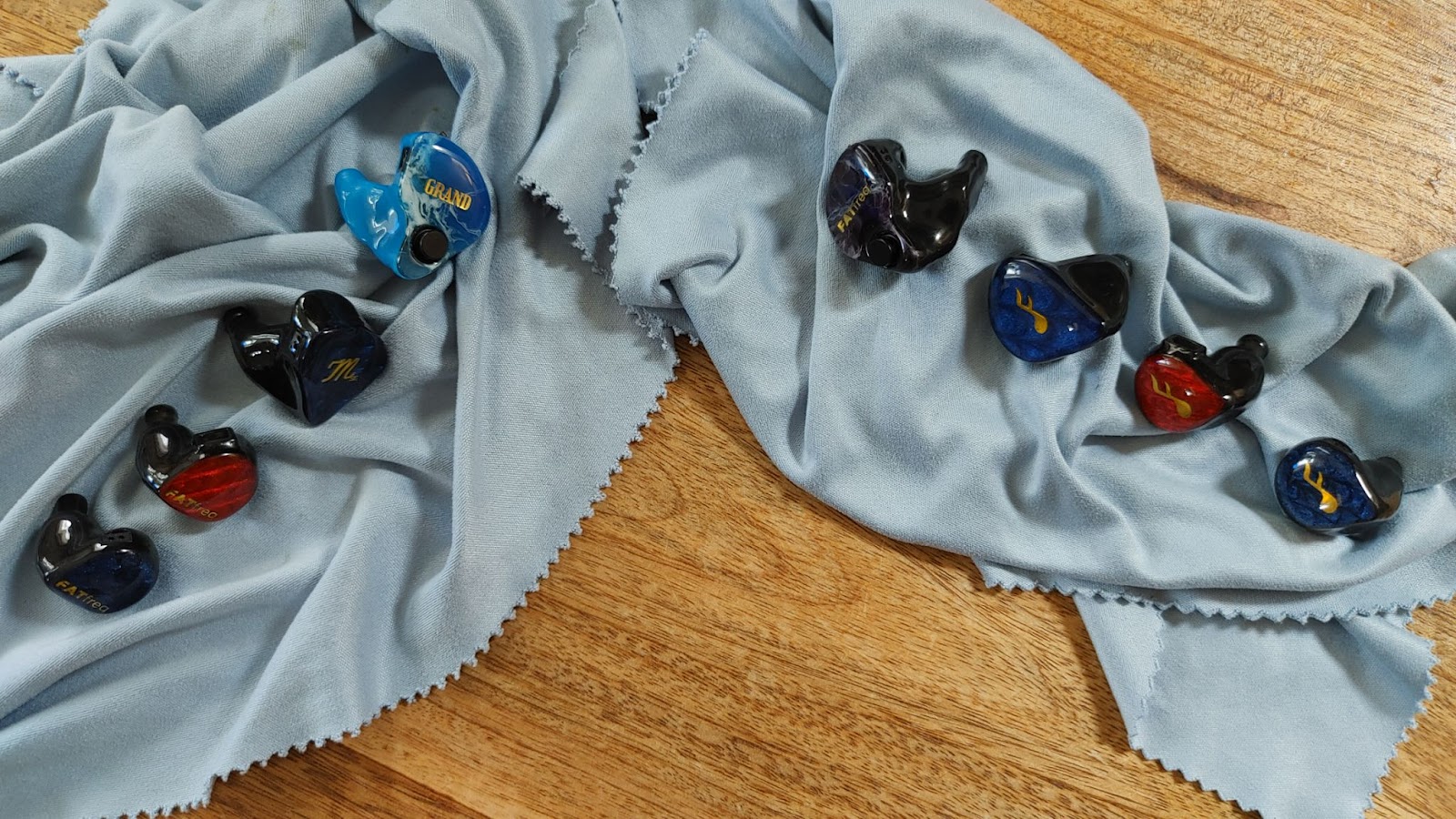
Meet the Maestros, bottom to top: Maestro Mini, Scarlet Mini, Maestro SE, Grand Maestro (CIEM)
Mini vs. Mini
Starting off the comparison series, we’ll cut to the chase and compare the Scarlet Mini (for the purpose of this review “Red”) to its blue bro, the OG Maestro Mini (“Blue”). Given this is the primary comparison of interest, I’m going to devote a whole section on this one and then combine the Maestro SE and Grand Maestro comparisons in part 2.
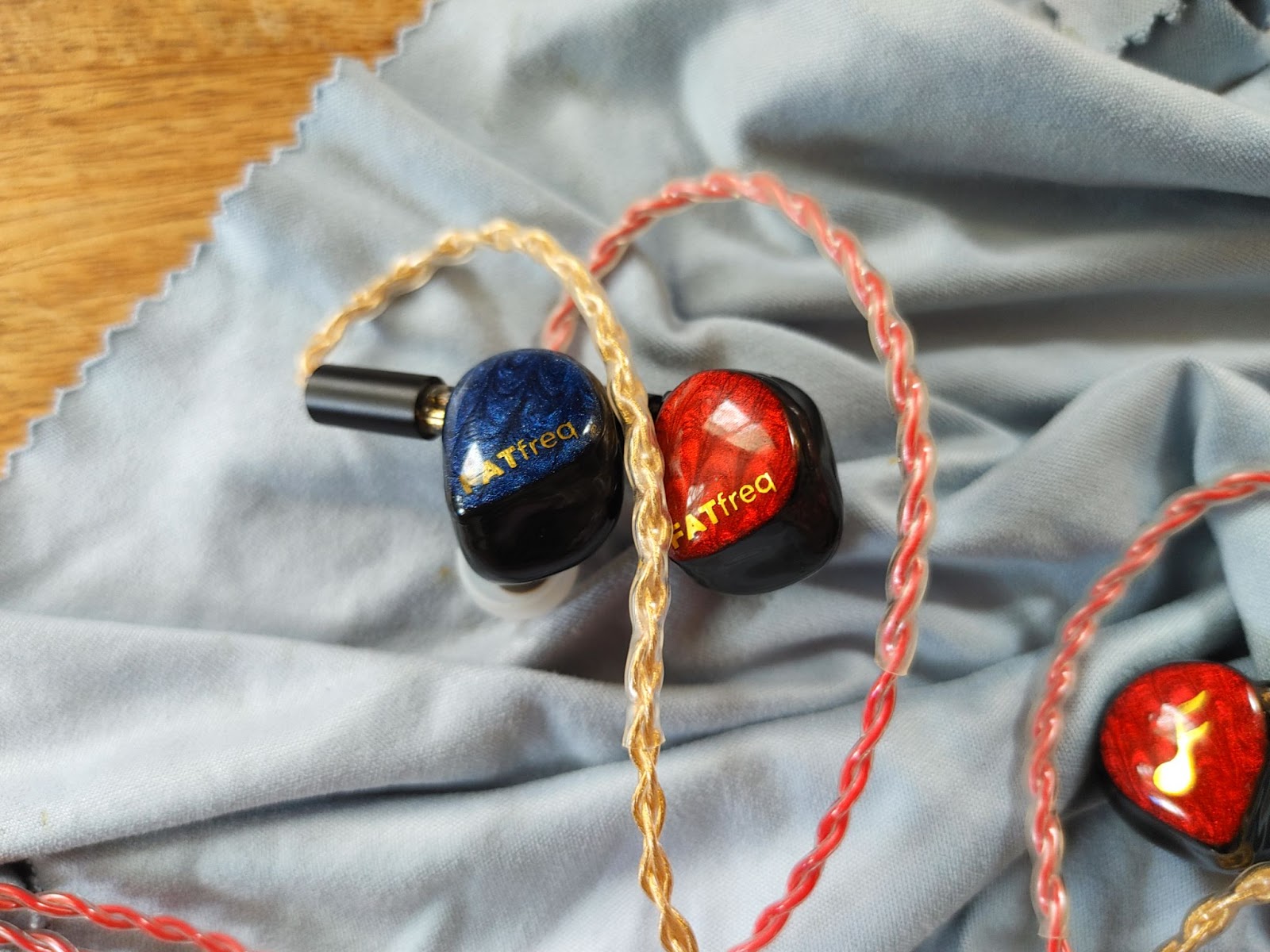
The Blue Maestro Mini were my introduction not only to the Maestros but to FATfreq as a whole. I was so impressed with them I blind bought a Grand Maestro within weeks and from there the sickness progressed
Technical
My Blue unit is one of the earlier run, without any meshguard (talk about tubeless lol!) so particularly on the build, there have been improvements made that aren’t exclusive to the Scarlet seen here, but are interesting to note. FATfreq have constantly been refining and improving their products based on the surge of customer interest and feedback, it’s quite impressive to see!
The Scarlet features the updated recessed 2 pin connector, now standard across FATfreq’s Maestro series as well. You can see on the Maestro some of the connector imperfections present in their earlier runs, it is much tidier on the new recessed mount.
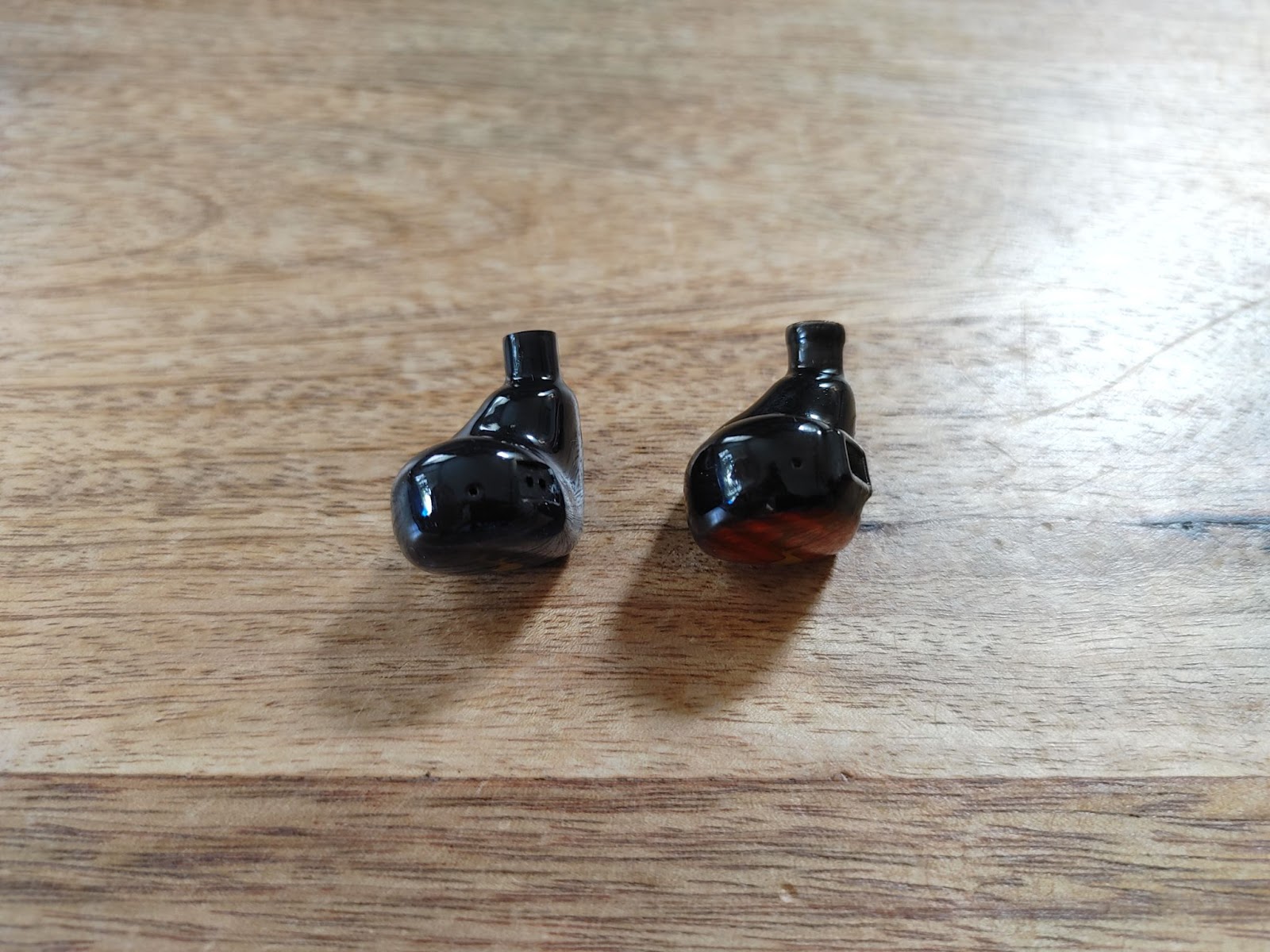
Also, note the improvements on the Scarlet nozzle profile. They’ve added a waist and taper to help it hold on to tips a bit better, something I appreciate a lot as the Mini’s are a bit prone to let them slide off.
Physically, the shape of the Scarlet is a bit more conformal, which made it surprising that, when I took these pictures, it was actually a bit larger than the OG:
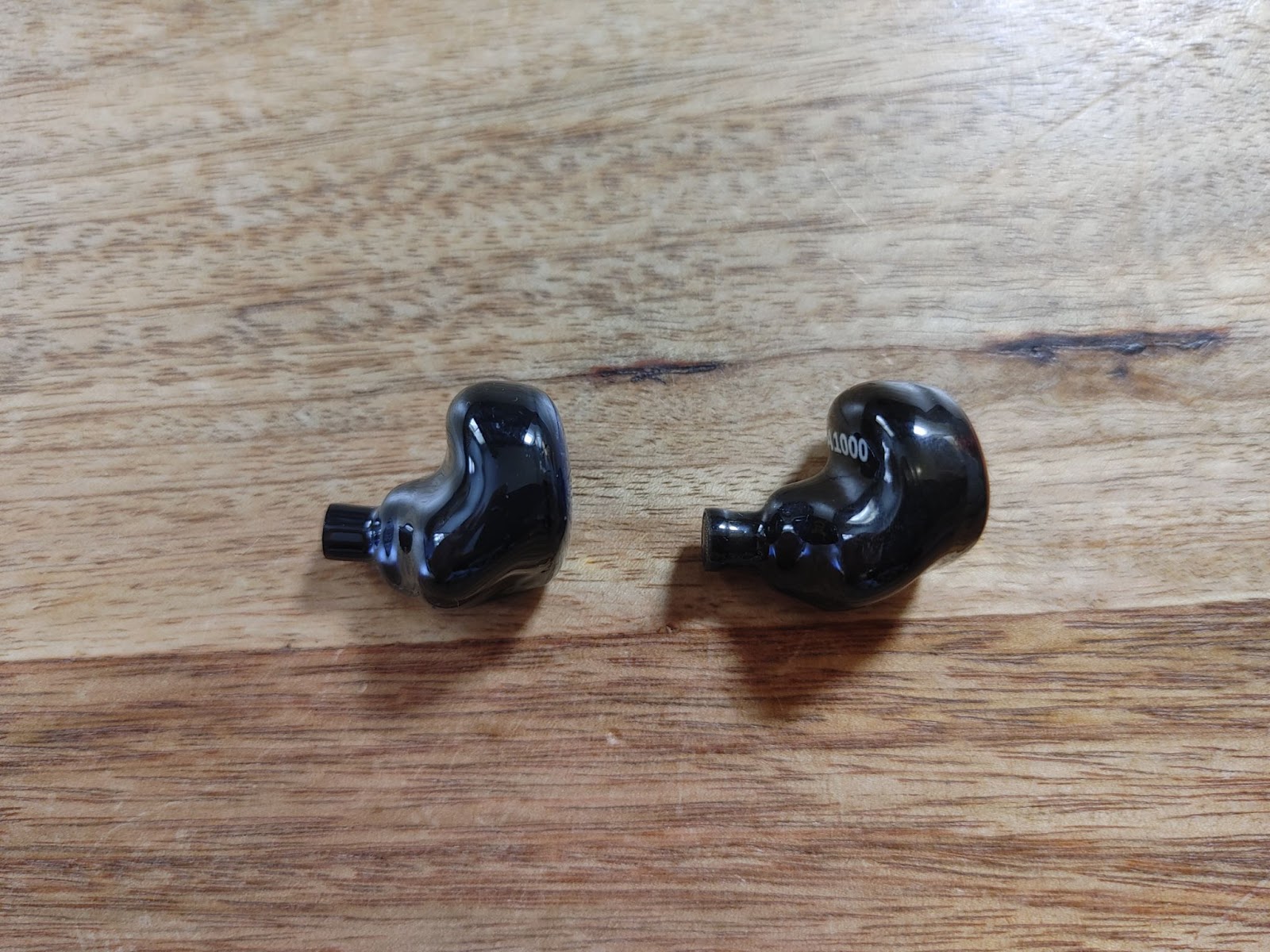

Note the exposed balanced armature on my Blue, these things really get the drivers into your ear!
I would be surprised if either Red or Blue caused substantial fit challenge. Both are relatively small by modern IEM standards and give lots of options to pivot in ear for the ideal placement.
The OG Blue mini contains 1 DD for Bass and 2 BA for mids and Treble… rather than depend on large drivers or higher counts, the minis put these in an exceptionally small form factor to get those drivers as close as possible to your eardrum. Seriously, look at that BA right in the nozzle in the above pic (covered by a mesh on newer Maestro Mini models, but impressive to see), that is bringing the sound right to your front door!
We can only speculate as to the configuration of the Scarlet - beyond at least that it is a multi driver, hybrid and not a tribrid. At least one of the BA’s is a new “Hypertweeter” that produces sound up to ultrasonics comparable to EST drivers to spec, something I’ll touch on in the sound off shortly.
In terms of sensitivity, I found them very similar in terms of power/SPL needs, both requiring substantially less than their Tribrid big bros.
Sound Off
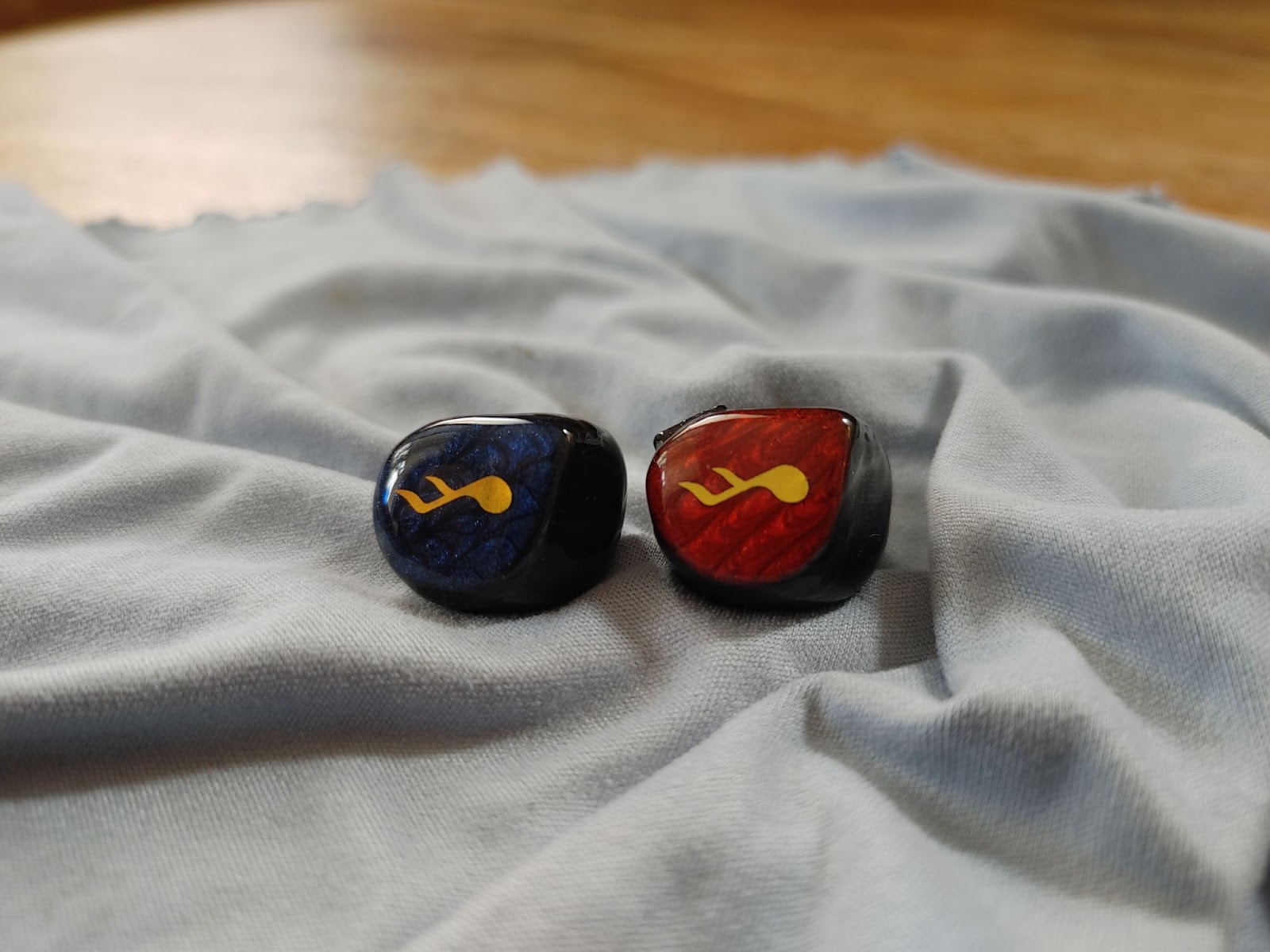
First things first. Yes the Scarlet has more bass than the Maestro Mini. Sub bass? Yes. Mid Bass? Yes. Bass Bass? YES.
It’s not a subtle difference either, it’s quite evident right away. Particularly the more forward boost protrudes higher up in frequency on Scarlet, so the Red’s Bass Cannon not only fires harder, it fires more often too. Whereas there are songs or even whole genres where you could listen to the Mini and not trigger the bass shelf at all, the boost is absolutely unavoidable on the Scarlet.
The tradeoff down low then depends on what aspect of FATfreq’s bass is most attractive to you. If you want the MOST bass, all day e’ry day, Scarlet is it. If you want a stealth basshead tuning that functions as a reference at fancy parties but somehow brings the woofer for Latenight, then the Maestro is the magic trick for you.
The upper mid and treble tuning differs quite radically. The lower/mid treble is much less pronounced on the Scarlet, this helps add to the sense of bass dominance, but it also masks some of the timbral shortcomings that are evident on the Blue mini which has relatively prominent ear gain. Whereas the upper mids / lower treble on the Scarlet is subdued, it’s a touch off kilter on the Maestro Mini, which adds a slightly cooler tonality to the otherwise textbook neutral mids/treble. Not necessarily unpleasant in either case, but a varying concession depending on your taste.
As advertised the hyper tweeter in the Scarlet does extend up to at least the 10s of kHz… it exposes some nasty edges in certain mixes or more frequently highlights recording noise. I’ll get into more detail (har har, pun fully intended!) on this topic when I compare the Scarlett to the EST loaded Tribrid MSE/GM, but in brief I find the combination of hyper detailed upper treble with subdued upper mids / lower treble on the Scarlet a bit unnatural. In most recordings it’s not an issue, but when it is noticeable I wouldn’t say to my ear it is an improvement over the more orthodox roll off in the Blue mini.
Any Color You Like
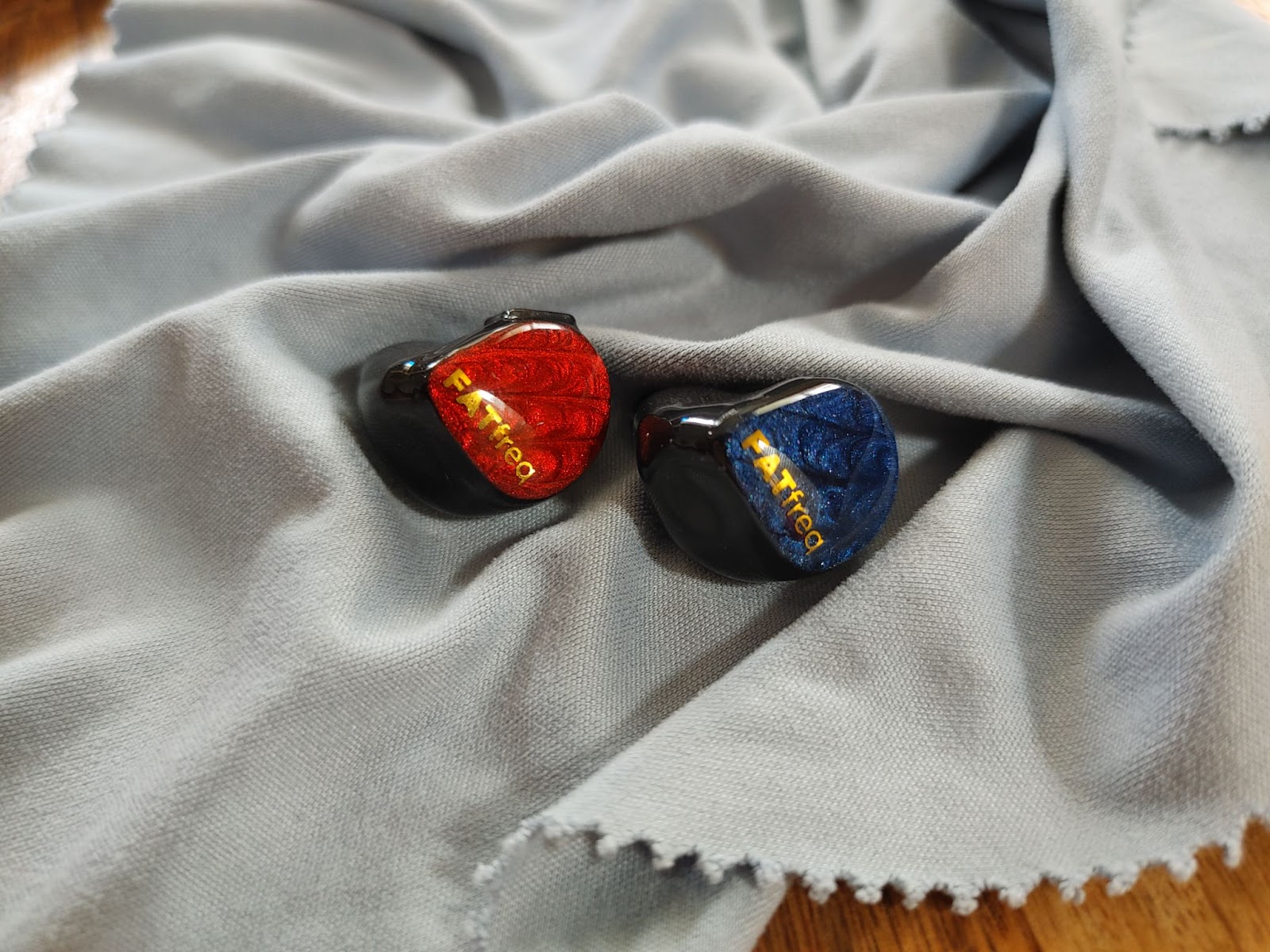
It should be clear that I take the view that the Scarlet is a specialist side grade compared to its more generalist forebear, the Maestro Mini. That is not to belittle the Scarlet or what it achieves within the realm it competes in. While imitators are trying to catch up to last year’s models… FATfreq have kicked up the Bass to a whole new level, topping even themselves.
There is a new Bass king in town, but the Maestro Mini’s Reference + Mega Bass is still unique. It seems like FATfreq don’t view Scarlet as a replacement either, thankfully keeping both available in their stable of offerings.
Regardless of your choice between minis, I think you will be happy. Be warned though, these mini bass cannons are highly addictive
Mini vs. Tribrids
Next, let's compare the Scarlet Mini to the two top end FATfreq Tribrid IEMs: the Maestro SE (MSE) and Grand Maestro (GM).
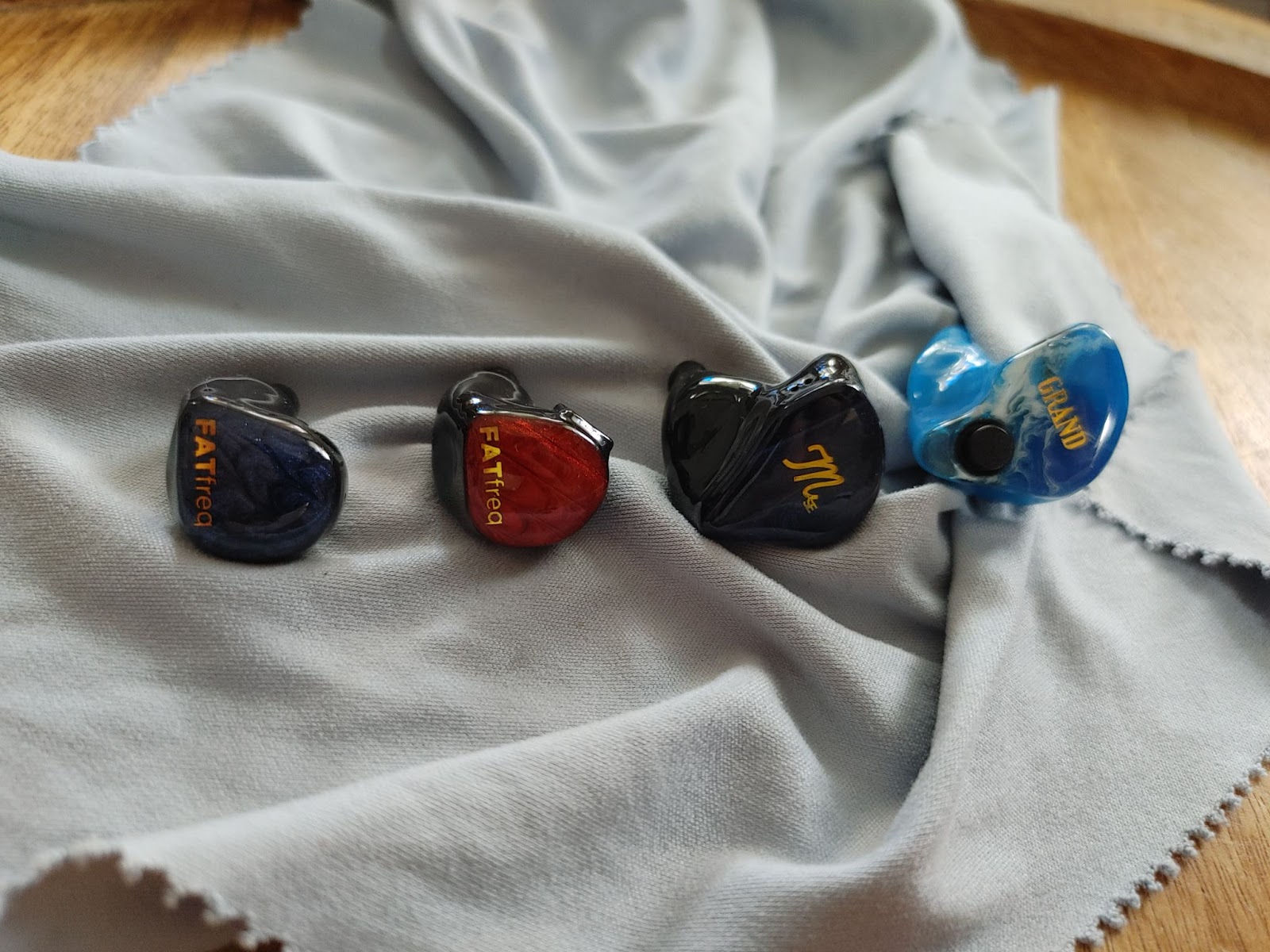
(left to right: FATfreq Maestro Mini, Scarlet Mini, Maestro SE, Grand Maestro CIEM)
Unfair? Absolutely, but everybody loves a good "David vs. Goliath" story, and - more importantly - it's good to understand how the addition of Scarlet affects the value prospect of the higher end models from FATfreq. Furthermore, the Scarlet features a new “Hypertweeter” balanced armature driver that is pegged to compete with electret (EST) drivers in the high frequencies which is interesting to qualify through listening.
Technical
My GM and MSE are pushing a year old now at the time of this review. My GM in particular is something of a prototype, they had not yet finalized the standard artwork for instance (so rather than FATfreq on the R piece, it should have the 16th note Semiquaver). In any case, newer MSEs and GMs have similar recessed 2 pin port to the Scarlet as was discussed previously. Instead, we’ll focus on the substantial fit differences and how this affects the product strategy.
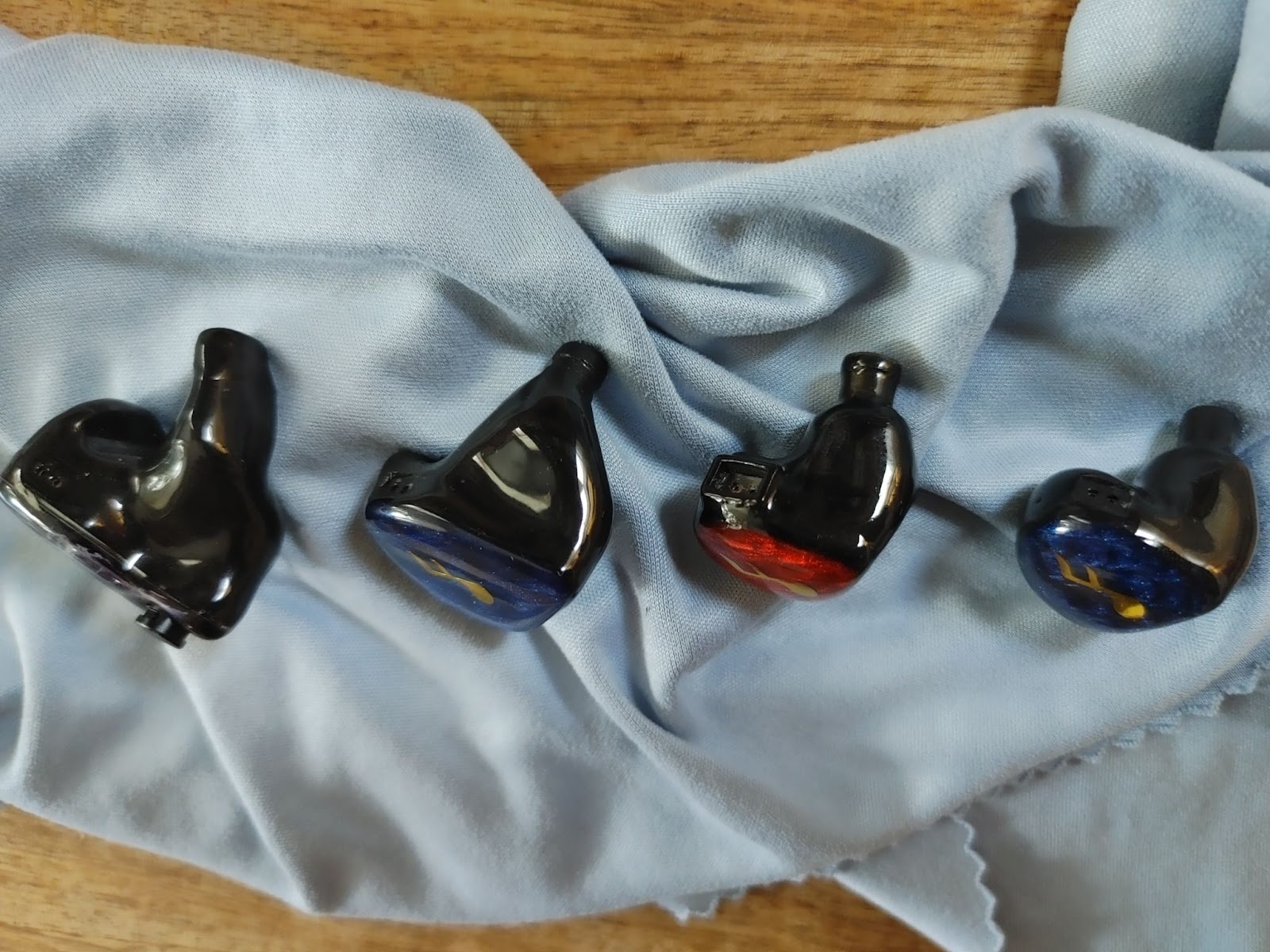
And the “mini” name starts to make more sense…
The MSE and GM are both 12 driver Tribrids, featuring configurations of 1 Dynamic Driver for bass, 7 Balanced Armature for mids and 4 Electret EST drivers for highs. As you can see, compared to the 3 driver hybrid configuration in the pair of Minis, this takes a TON of space to fit. The body size on the MSE and GM are substantially larger, and I have found the Uni MSE to be a relatively hard IEM to fit.
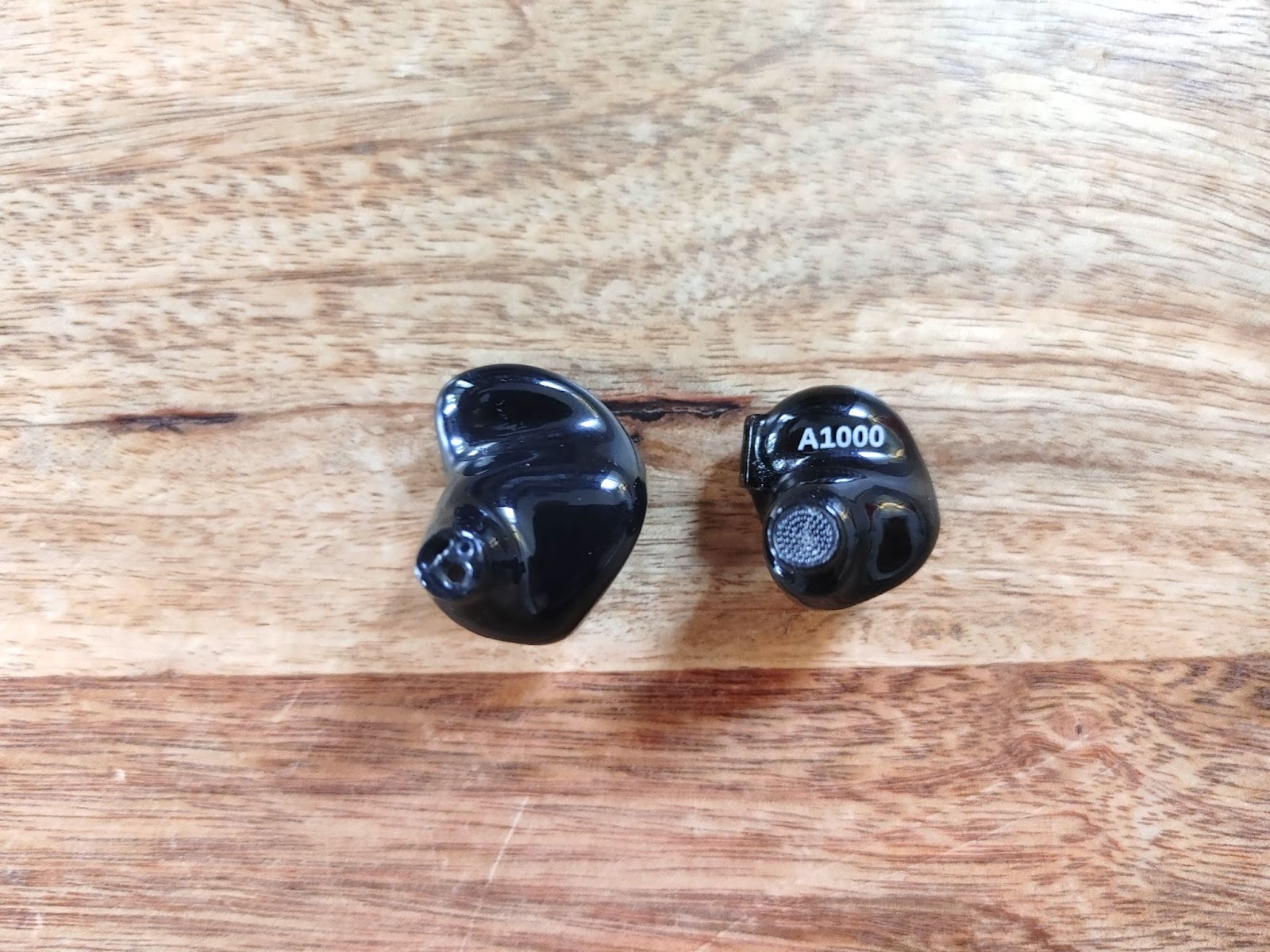
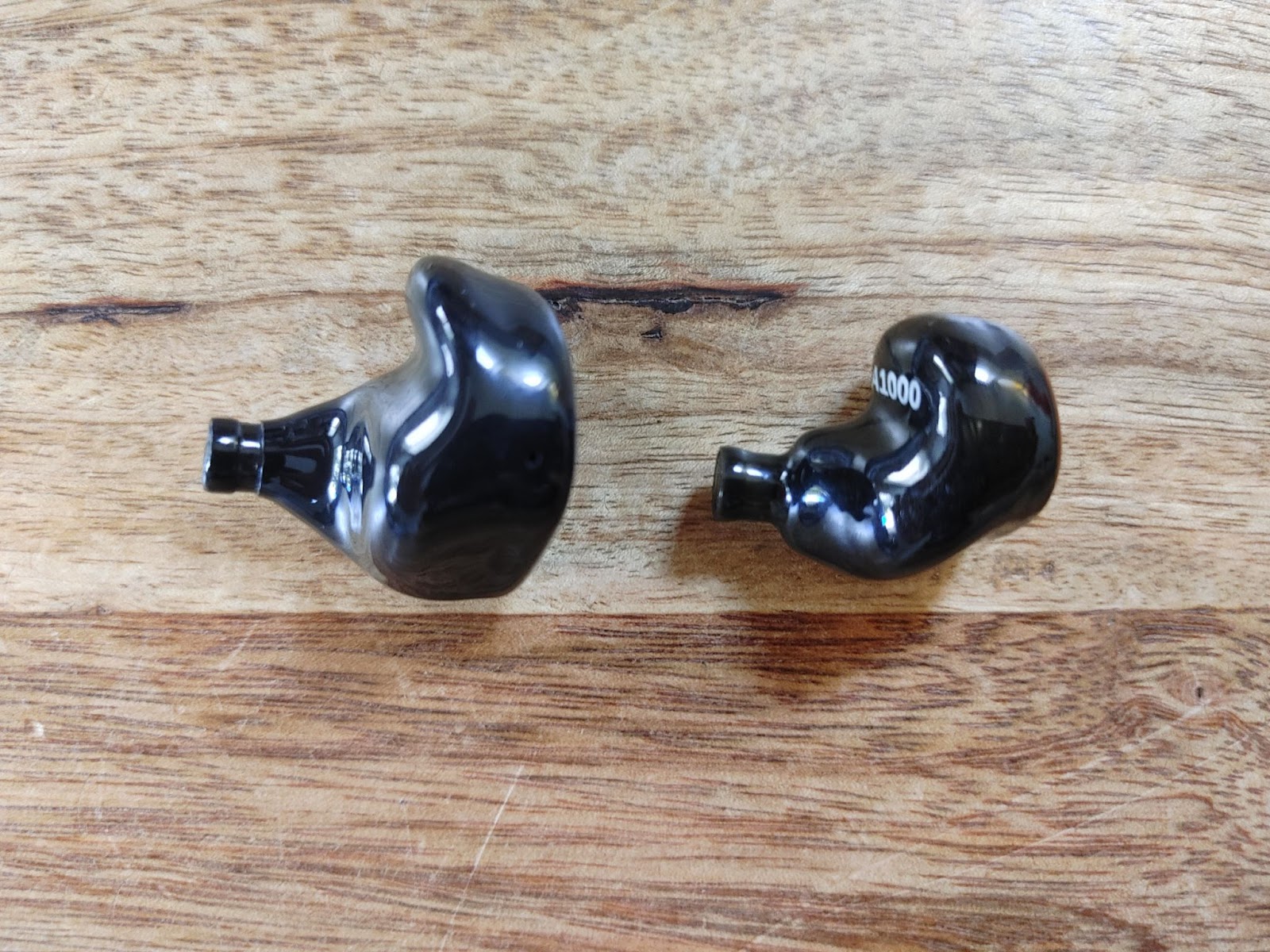
MSE (left) and Scarlet (right)
This is a nice illustration of the fundamental trade off at play in driver configuration. A smaller footprint allows for housing that is compact enough to get the drivers themselves deeply inserted into the ear, whereas the Tribrids need an acoustic feed (tubes etc) to route the sound into your canal. The “bang for your buck” per driver is dominated by proximity to the ear drum, so the Mini’s 3 drivers hit far harder than the corresponding trio would back in the larger housing. We’ll talk more about the sonic implications in the Sound Off up next.
Of course, a time tested strategy for dealing with larger driver configurations and the ensuing volume is to opt for a Custom IEM (CIEM) shell. FATfreq began as a custom shop, and retain a strong tradition of CIEM design and manufacturing.
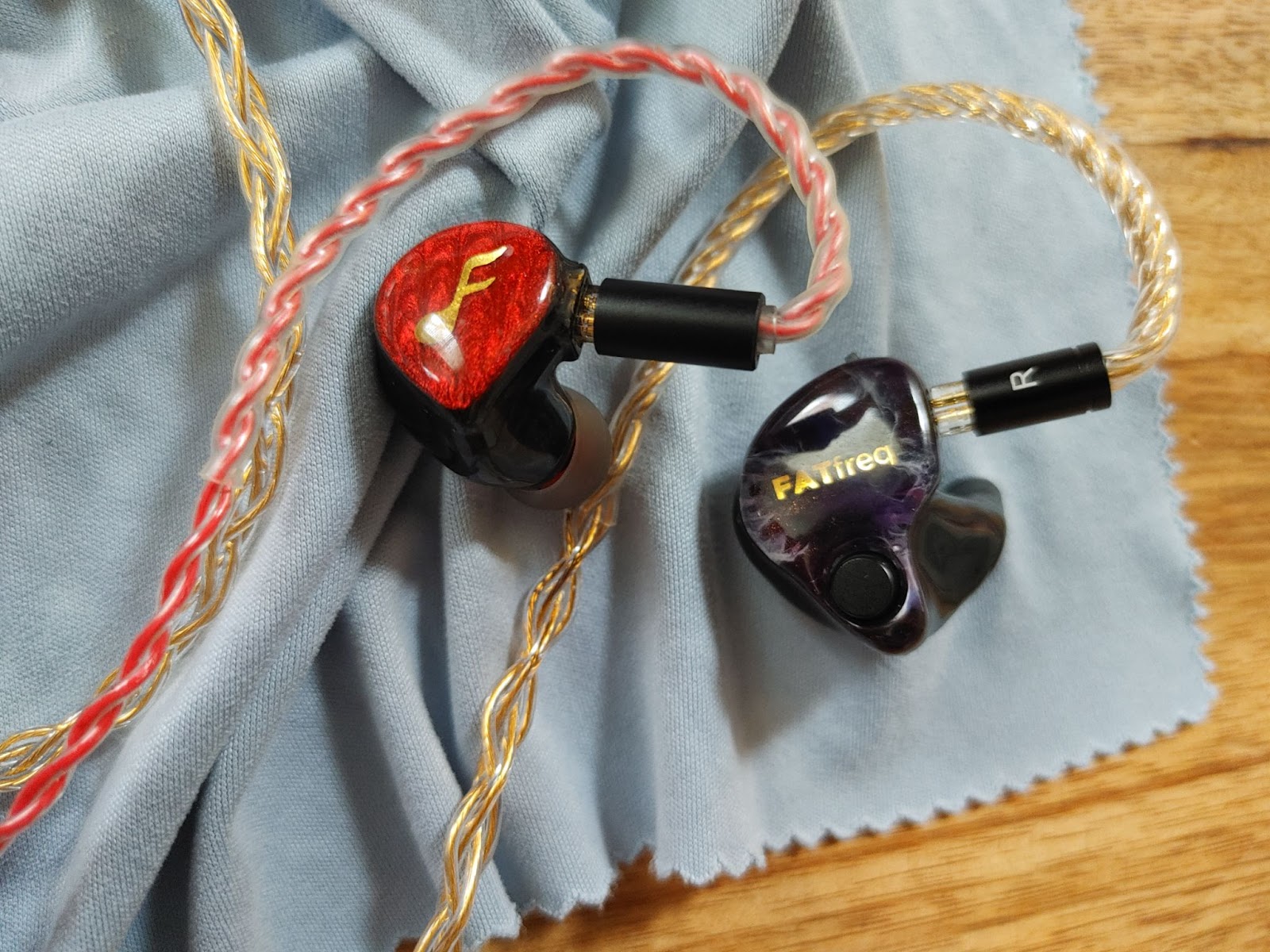
Scarlet Mini (left) and Grand Maestro CIEM (right)
This removes the fit variable, and makes for the ideal comparison vs. the deeply inserted drivers of the mini.
Sensitivity wise, both Tribrids require SUBSTANTIALLY more power than the Minis (like 10+ dB, basically a higher gain mode). I quite like hard to drive IEMs as it gives lots of flexibility for amplification. Fortunately the Minis are not exceptionally sensitive and are not prone to over saturation (background hissing) on any of my amps or DAP.
Sound Off
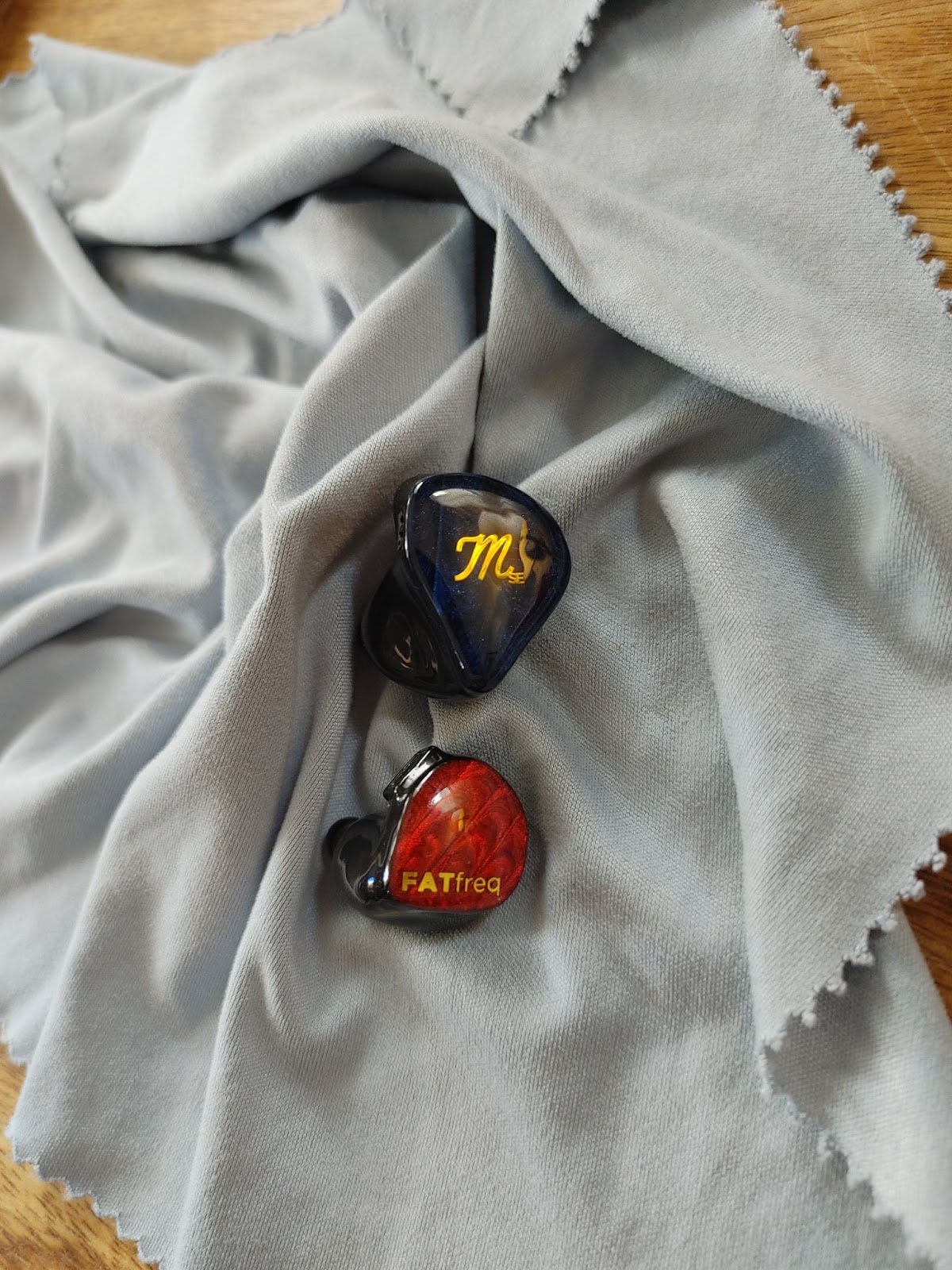
The MSE exemplifies the Maestro ultra tucked sub bass shelf plus reference tuning, that FATfreq have become famous for. In its upper mids and lower treble, it features a relatively textbook diffused field tuning, sounding a bit boring and reference like - until there’s content sub 150 Hz. Unlike the Maestro Mini, there’s no niggling minor timbral offset and it produces a clean, even slightly lean overall profile.
This starkly contrasts the mids/lower treble on the Scarlet that as previously mentioned are subdued to minimize the tuning impact and maximize apparent bass.
In combination with the much higher upper bass of the Scarlet, this means that the MSE sounds very cool and lean in comparison. Folks that found MSE slightly boring would do well to give the brand another chance with Scarlet.
Sub bass can get tricky to qualify at these high amplitude levels. But the Scarlet has notably more sub impact and presence than the MSE, which used to be my sub bass high water mark. It’s not something that requires focus or extensive comparison to qualify like the GM vs. MSE either… it’s quite immediately evident that Scarlet is the new Bass king.
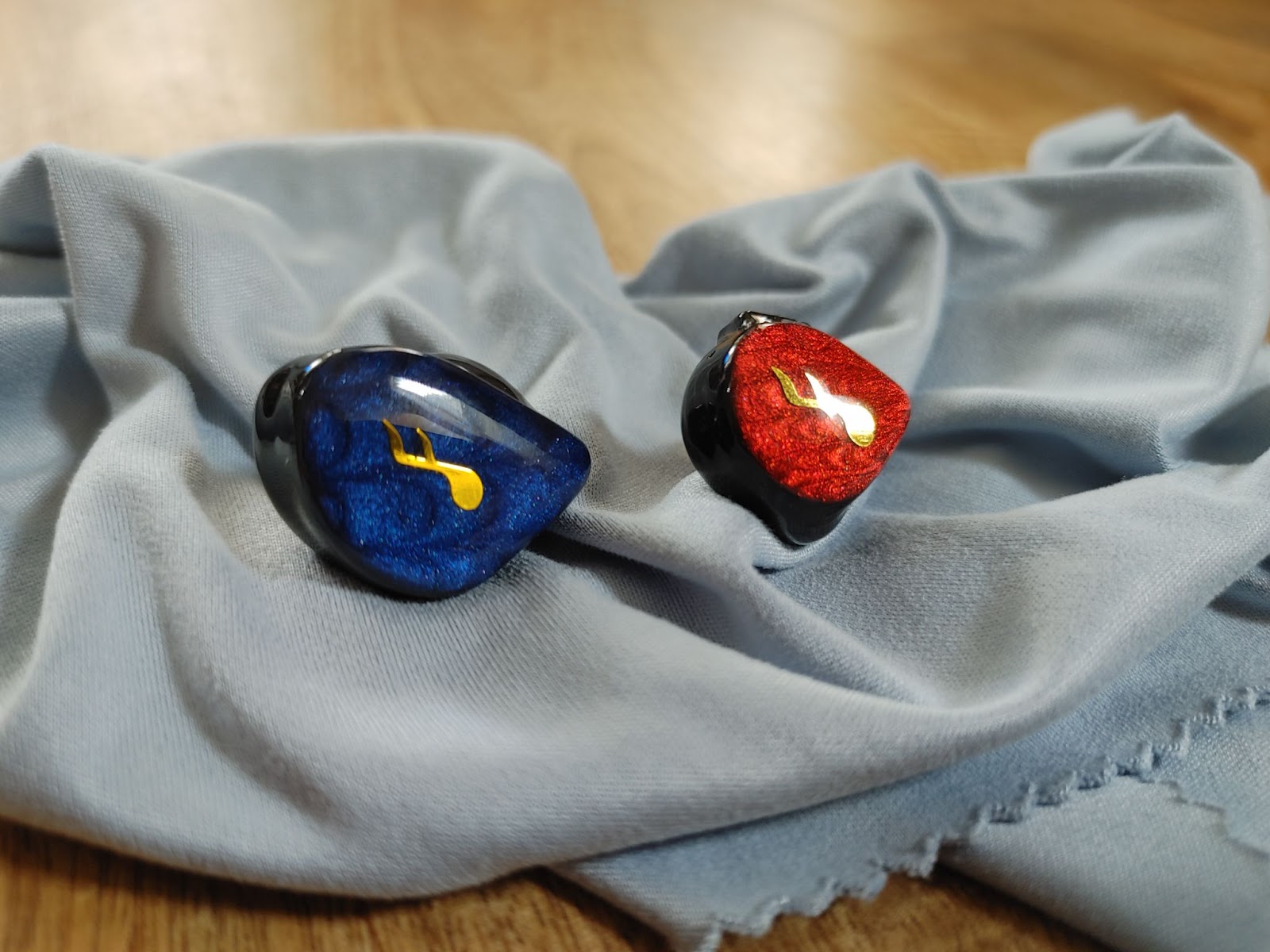
Up high, true to their marketing FATfreq’s new Hypertweeter is definitely passing on detail and air comparably to the EST’s in the MSE. Unfortunately, because of the noted subdued mids, the extra treble energy seems a bit off for me on the Scarlet… with the ear gain profile of the MSE it makes sense and is part of a pleasant complete spectrum, but with Scarlet it kind of pops out of nowhere.
I can appreciate the challenge FATfreq faced here, bringing out details like this while sharing the stage with elephantine levels of bass is no easy task I’d imagine. Still, there’s no denying that the MSE’s EST drivers sound natural and impressive whereas the Hypertweeter although capable feels a bit gimmicky in the context of the Scarlet’s tuning.
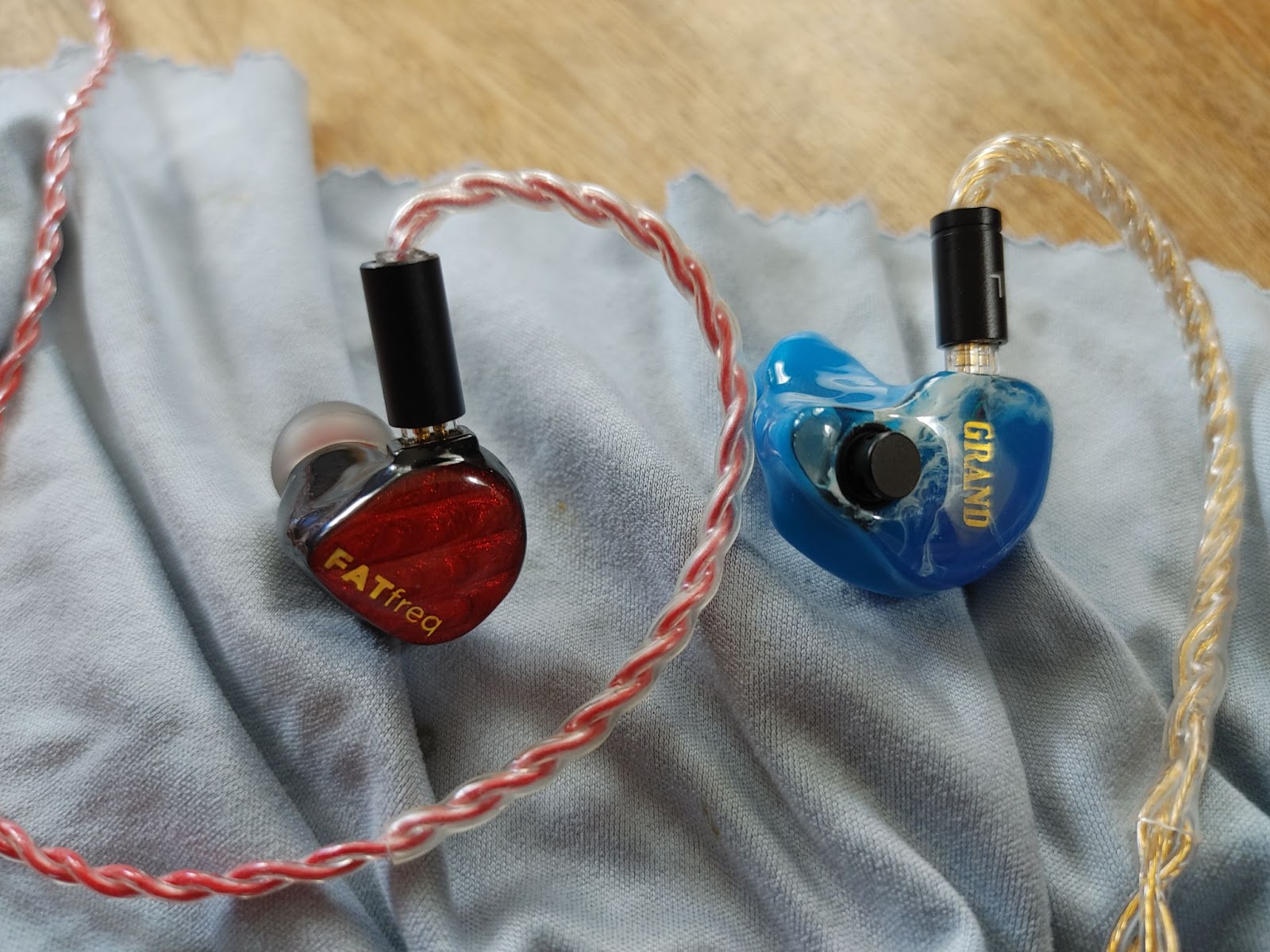
The GM takes the tribrid configuration present in the MSE and adds a pressure equalization and tuning module that FATfreq call NOAH, as well as a tuning switch that allows you to deactivate the bass shelf in what they call "vocal boost" mode. To simplify comparison, I will be referencing the GM’s black, non vocal mode, which is the most similar to the MSE and Scarlet. The flexibility with the Blue (and tbd) NOAH modules and switch is a huge value prospect for the GM, but is outside the scope of this discussion.
Here, however, is where things got truly unfair… the equalized pressure is absolutely transformative in the quality of bass produced. I’ll just directly quote my notes here: “Unfair. Bass is less voluminous but eminently more textured. With equalized pressure, a transient process is revealed. Detail has delineation and edginess without sharpness.”
After A/B between GM and Scarlet, I absentmindedly kept the GM in ear afterwards and just kept listening for the entire album. Such a wonderful IEM.
Particularly with the SPL produced for the level of Subbass present in MSE and even more so Scarlet, having pressure equalization like on the GM with Black filter removes fatigue and allows our ears to extract more detail than I thought was possible at <50 Hz.
WIth the semi open cleanliness generally, the ESTs in the GM also particularly shine. They are more emphasized than on the MSE but with the open clarity I generally don’t find it objectionable. It lets them get away pushing a lot more detail than I would generally like in traditional unvented designs.
End of Line?
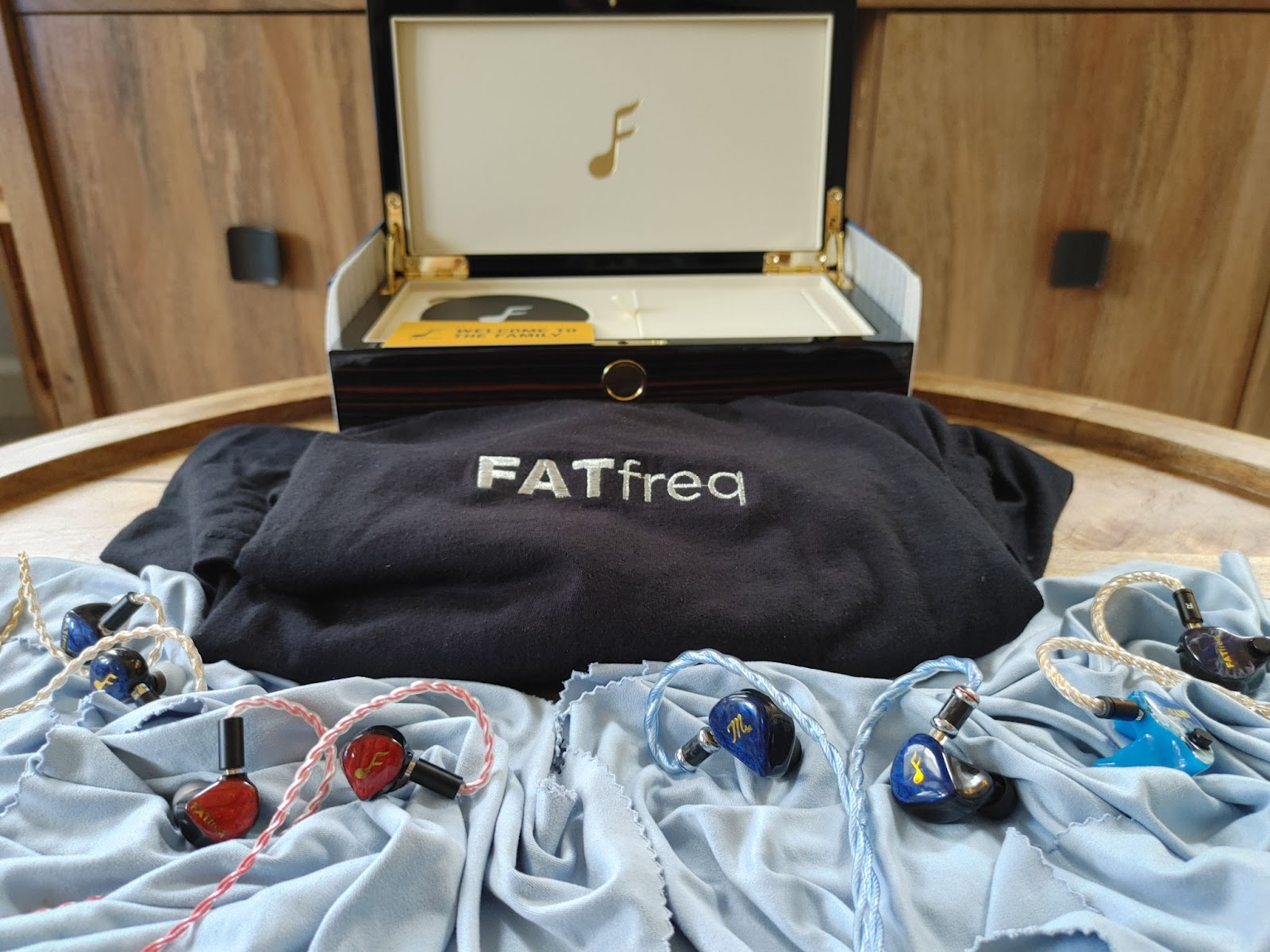
It’s truly impressive what the team at FATfreq have pulled off with Scarlet. It has a focus of purpose that allows it to achieve new heights in bass, not just for IEMs but for home audio period. This directivity comes at the cost of flexibility… certainly more so than their existing Maestro peers.
Compared to FATfreq’s existing TOTL models, the Scarlet doesn’t disrupt things too much, rather provides a welcome capable specialist to the selection. While the absolute sub bass king title of the MSE is now Red’s to own, the MSE’s textbook overall execution is still outstanding and well worth the cost of entry (both dollar and fit)! The GM’s equalized pressure venting is surprisingly effective for bass oriented tunings. The extra comfort and detail it brings make the concession to the bass level on the Scarlet remain palatable.

The right driver in the wrong place can make all the difference in the world...
The entire experience has left me dreaming of a vented “Scarlet turbo”, that combines the proximal driver benefits of the mini with the incredible textural delivery of the GM's venting. The open clarity might also shed a more flattering light on the hyper tweeter too in the process. Even as one reaches new summits of experience in this hobby, it is a good thing to keep dreaming
Bonus Round: Bass for the Ages
Does the Scarlet bass transcend topology?
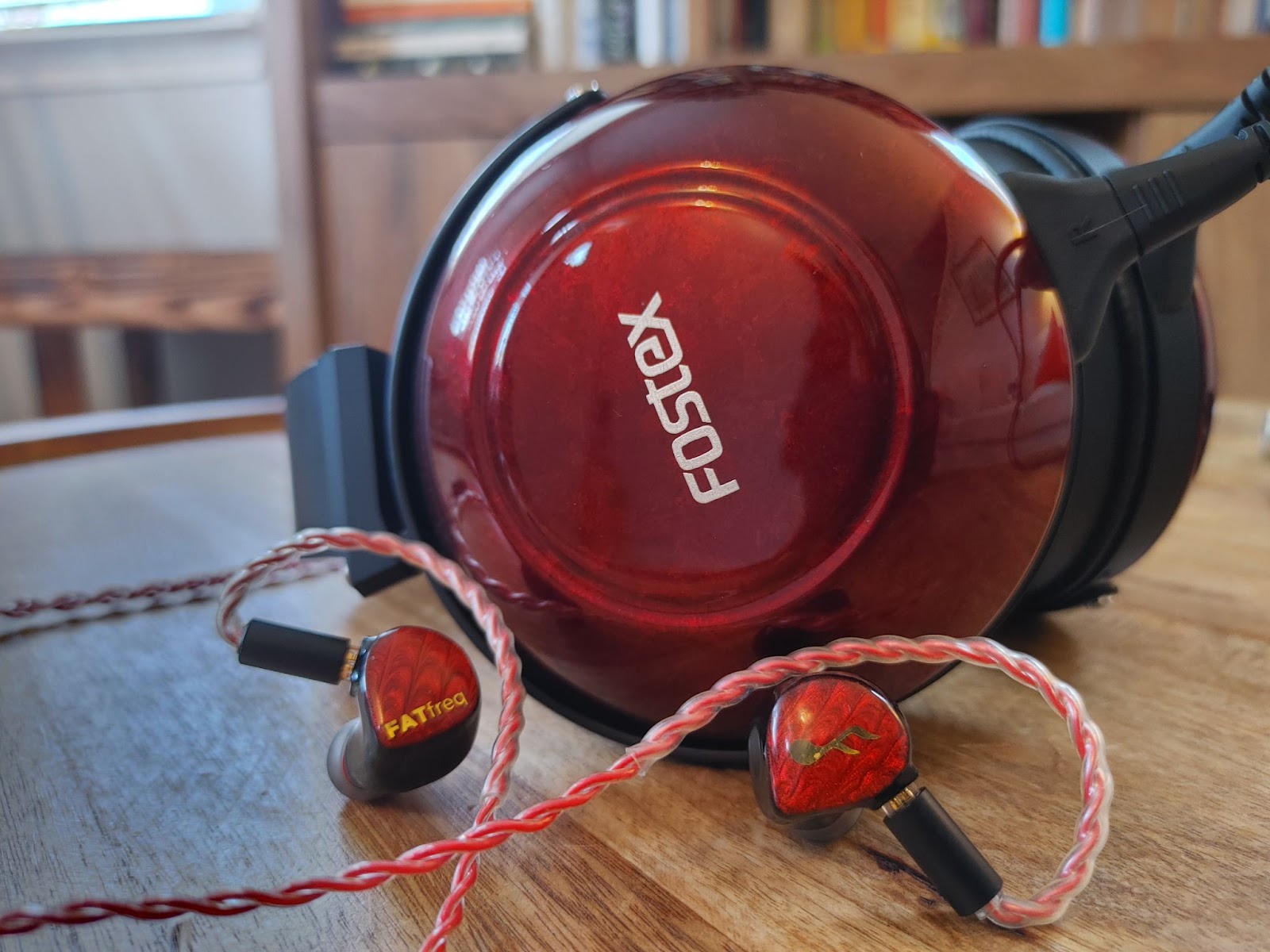
In my spare time, when not greedily stuffing my ears with as many IEMs as possible, I maintain a collection of Fostex Biodyna TOTL headphones (TH900m2 Red, TH900m2 Pearl White, TH909, TrX Ebony). These models are Fostex’ own premium take on the evergreen Biodyna OEM models (EMu, Denon D2000/5000/7000 etc). In addition to the biocellulose driver’s exceptional low distortion (same tech that was in the legendary Sony MDR-R10), they are also notorious for their strong bass performance. The TH900 Red in particular remains a Bass head’s staple for over ear.
I was curious how the Reds would compare head to head, for Science
To cut to the chase, yes the Scarlet has more bass than the TH900. It’s not close. But it’s also not as far off as one would think looking at the frequency responses. But if you convinced a “normie” in your life to try both, they wouldn’t hesitate to tell you the Scarlet has more bass, even if they struggled to tell you exactly why.
The sensation of bass with IEMs is fundamentally different to on-ear. The haptics of over ear produces a lot of intrinsic bone conduction. This occurrs from the headphone’s mechanical surface touching your skin (pads and clamp), while also being coupled to the driver. You can think of this as a huge version of FIR’s Kinetic Bass, that envelopes your whole ear. The concept of “slam” makes more sense in this context. The driver and haptic response are literally barraging the side of your head with Bass energy.
For IEMs, like Scarlet, the internal nature of the source is very evident. It feels like there is a sub-woofer in my ear canal and the bass energy is trying to explode outward. There’s much less area for natural BCD around the canal. Factor in the higher acoustic impedance IEMs face in low frequencies, and a picture where you need to add 5-10 dB of bass boost to an IEM for the same apparent bass level starts to make sense.
So no, I’m not listing my Fostex in the classifieds any time soon, but YES the Scarlet Mini produces bass at a much higher level - even notable beyond the dramatic perceptual differences discussed.
I have had some ear time with the new FATfreq Scarlet Mini now and my ears are starting to wrap around just how much bass this thing is injecting skullside. At least, when they are not cowering in fear.
This review will take the form of some brief initial impressions of the IEM and accessories, and then two parts of comparisons. First off, we'll compare the new Scarlet Mini to its blue bro, the Maestro Mini and then to its tribrid siblings the Maestro SE and Grand Maestro. There's also a bonus basshead comparison at the end, so be sure to scroll all the way through


In the world of IEMs and headphones, there are "all rounder" tunings and "specialist" tunings. The Scarlet is undeniably a specialist, a specialist's specialist even... a Basshead's bassy IEM. This thing is the Cardinal of Bass:

Who you calling mini?
I have mainly been listening to electronic music with them for which they are such a treat. The sub bass is as advertised even more crazy than the blue line, but the overall tuning and the detail brought from the new hypertweeter really keep things energized. The balancing act the team at FATfreq have pulled off here is incredible. Delivering this much payload while maintaining coherence - let alone a nice amount of detail - a true challenge.
This is not to say it will be an IEM for everyone or all music of course. The bass is front and center, and care of a slightly more forward tuning is more frequently present than in the Maestro. While I think you could get away calling most Maestros Neutral with epic sub bass, the extra mid bass here definitely pushes these into a more pronounced v shape tuning. But when they work, for ears that are ready... these are special in a way I haven't felt since the OG mini

Packaging and Accessories
Before we dive into the two rounds of comparisons, let's briefly comment on the quite nice accessories that came with Scarlet:

The sheer redness of the thing lol...
The first batch of Scarlets come with in a clever matching scarlet red pelican style case (FATfreq's own "FATbox"). For the first 300 units the red silver upgrade cable is available for free and afterwards looks like it will be ~$100.

The Hypertweeter deserves silver cable!
In each case (har har) the cosmetic pairing is delightful. While nothing world shaking, the silver cable with modular termination is a very nice inclusion and a big upgrade from what they included with their IEMs last year.
On with the show!
Red vs. Blue: Scarlet and the Maestros
I have been busy hard at work comparing the Scarlet to my
 But for my fellow head-fiers, I will go that extra mile! In particular: the Maestro Mini, the Maestro SE and the Grand Maestro.
But for my fellow head-fiers, I will go that extra mile! In particular: the Maestro Mini, the Maestro SE and the Grand Maestro.Meet the Maestros, bottom to top: Maestro Mini, Scarlet Mini, Maestro SE, Grand Maestro (CIEM)
Mini vs. Mini
Starting off the comparison series, we’ll cut to the chase and compare the Scarlet Mini (for the purpose of this review “Red”) to its blue bro, the OG Maestro Mini (“Blue”). Given this is the primary comparison of interest, I’m going to devote a whole section on this one and then combine the Maestro SE and Grand Maestro comparisons in part 2.
The Blue Maestro Mini were my introduction not only to the Maestros but to FATfreq as a whole. I was so impressed with them I blind bought a Grand Maestro within weeks and from there the sickness progressed
Technical
My Blue unit is one of the earlier run, without any meshguard (talk about tubeless lol!) so particularly on the build, there have been improvements made that aren’t exclusive to the Scarlet seen here, but are interesting to note. FATfreq have constantly been refining and improving their products based on the surge of customer interest and feedback, it’s quite impressive to see!
The Scarlet features the updated recessed 2 pin connector, now standard across FATfreq’s Maestro series as well. You can see on the Maestro some of the connector imperfections present in their earlier runs, it is much tidier on the new recessed mount.
Also, note the improvements on the Scarlet nozzle profile. They’ve added a waist and taper to help it hold on to tips a bit better, something I appreciate a lot as the Mini’s are a bit prone to let them slide off.
Physically, the shape of the Scarlet is a bit more conformal, which made it surprising that, when I took these pictures, it was actually a bit larger than the OG:
Note the exposed balanced armature on my Blue, these things really get the drivers into your ear!
I would be surprised if either Red or Blue caused substantial fit challenge. Both are relatively small by modern IEM standards and give lots of options to pivot in ear for the ideal placement.
The OG Blue mini contains 1 DD for Bass and 2 BA for mids and Treble… rather than depend on large drivers or higher counts, the minis put these in an exceptionally small form factor to get those drivers as close as possible to your eardrum. Seriously, look at that BA right in the nozzle in the above pic (covered by a mesh on newer Maestro Mini models, but impressive to see), that is bringing the sound right to your front door!
We can only speculate as to the configuration of the Scarlet - beyond at least that it is a multi driver, hybrid and not a tribrid. At least one of the BA’s is a new “Hypertweeter” that produces sound up to ultrasonics comparable to EST drivers to spec, something I’ll touch on in the sound off shortly.
In terms of sensitivity, I found them very similar in terms of power/SPL needs, both requiring substantially less than their Tribrid big bros.
Sound Off
First things first. Yes the Scarlet has more bass than the Maestro Mini. Sub bass? Yes. Mid Bass? Yes. Bass Bass? YES.
It’s not a subtle difference either, it’s quite evident right away. Particularly the more forward boost protrudes higher up in frequency on Scarlet, so the Red’s Bass Cannon not only fires harder, it fires more often too. Whereas there are songs or even whole genres where you could listen to the Mini and not trigger the bass shelf at all, the boost is absolutely unavoidable on the Scarlet.
The tradeoff down low then depends on what aspect of FATfreq’s bass is most attractive to you. If you want the MOST bass, all day e’ry day, Scarlet is it. If you want a stealth basshead tuning that functions as a reference at fancy parties but somehow brings the woofer for Latenight, then the Maestro is the magic trick for you.
The upper mid and treble tuning differs quite radically. The lower/mid treble is much less pronounced on the Scarlet, this helps add to the sense of bass dominance, but it also masks some of the timbral shortcomings that are evident on the Blue mini which has relatively prominent ear gain. Whereas the upper mids / lower treble on the Scarlet is subdued, it’s a touch off kilter on the Maestro Mini, which adds a slightly cooler tonality to the otherwise textbook neutral mids/treble. Not necessarily unpleasant in either case, but a varying concession depending on your taste.
As advertised the hyper tweeter in the Scarlet does extend up to at least the 10s of kHz… it exposes some nasty edges in certain mixes or more frequently highlights recording noise. I’ll get into more detail (har har, pun fully intended!) on this topic when I compare the Scarlett to the EST loaded Tribrid MSE/GM, but in brief I find the combination of hyper detailed upper treble with subdued upper mids / lower treble on the Scarlet a bit unnatural. In most recordings it’s not an issue, but when it is noticeable I wouldn’t say to my ear it is an improvement over the more orthodox roll off in the Blue mini.
Any Color You Like
It should be clear that I take the view that the Scarlet is a specialist side grade compared to its more generalist forebear, the Maestro Mini. That is not to belittle the Scarlet or what it achieves within the realm it competes in. While imitators are trying to catch up to last year’s models… FATfreq have kicked up the Bass to a whole new level, topping even themselves.
There is a new Bass king in town, but the Maestro Mini’s Reference + Mega Bass is still unique. It seems like FATfreq don’t view Scarlet as a replacement either, thankfully keeping both available in their stable of offerings.
Regardless of your choice between minis, I think you will be happy. Be warned though, these mini bass cannons are highly addictive
Mini vs. Tribrids
Next, let's compare the Scarlet Mini to the two top end FATfreq Tribrid IEMs: the Maestro SE (MSE) and Grand Maestro (GM).
(left to right: FATfreq Maestro Mini, Scarlet Mini, Maestro SE, Grand Maestro CIEM)
Unfair? Absolutely, but everybody loves a good "David vs. Goliath" story, and - more importantly - it's good to understand how the addition of Scarlet affects the value prospect of the higher end models from FATfreq. Furthermore, the Scarlet features a new “Hypertweeter” balanced armature driver that is pegged to compete with electret (EST) drivers in the high frequencies which is interesting to qualify through listening.
Technical
My GM and MSE are pushing a year old now at the time of this review. My GM in particular is something of a prototype, they had not yet finalized the standard artwork for instance (so rather than FATfreq on the R piece, it should have the 16th note Semiquaver). In any case, newer MSEs and GMs have similar recessed 2 pin port to the Scarlet as was discussed previously. Instead, we’ll focus on the substantial fit differences and how this affects the product strategy.
And the “mini” name starts to make more sense…
The MSE and GM are both 12 driver Tribrids, featuring configurations of 1 Dynamic Driver for bass, 7 Balanced Armature for mids and 4 Electret EST drivers for highs. As you can see, compared to the 3 driver hybrid configuration in the pair of Minis, this takes a TON of space to fit. The body size on the MSE and GM are substantially larger, and I have found the Uni MSE to be a relatively hard IEM to fit.
MSE (left) and Scarlet (right)
This is a nice illustration of the fundamental trade off at play in driver configuration. A smaller footprint allows for housing that is compact enough to get the drivers themselves deeply inserted into the ear, whereas the Tribrids need an acoustic feed (tubes etc) to route the sound into your canal. The “bang for your buck” per driver is dominated by proximity to the ear drum, so the Mini’s 3 drivers hit far harder than the corresponding trio would back in the larger housing. We’ll talk more about the sonic implications in the Sound Off up next.
Of course, a time tested strategy for dealing with larger driver configurations and the ensuing volume is to opt for a Custom IEM (CIEM) shell. FATfreq began as a custom shop, and retain a strong tradition of CIEM design and manufacturing.
Scarlet Mini (left) and Grand Maestro CIEM (right)
This removes the fit variable, and makes for the ideal comparison vs. the deeply inserted drivers of the mini.
Sensitivity wise, both Tribrids require SUBSTANTIALLY more power than the Minis (like 10+ dB, basically a higher gain mode). I quite like hard to drive IEMs as it gives lots of flexibility for amplification. Fortunately the Minis are not exceptionally sensitive and are not prone to over saturation (background hissing) on any of my amps or DAP.
Sound Off
The MSE exemplifies the Maestro ultra tucked sub bass shelf plus reference tuning, that FATfreq have become famous for. In its upper mids and lower treble, it features a relatively textbook diffused field tuning, sounding a bit boring and reference like - until there’s content sub 150 Hz. Unlike the Maestro Mini, there’s no niggling minor timbral offset and it produces a clean, even slightly lean overall profile.
This starkly contrasts the mids/lower treble on the Scarlet that as previously mentioned are subdued to minimize the tuning impact and maximize apparent bass.
In combination with the much higher upper bass of the Scarlet, this means that the MSE sounds very cool and lean in comparison. Folks that found MSE slightly boring would do well to give the brand another chance with Scarlet.
Sub bass can get tricky to qualify at these high amplitude levels. But the Scarlet has notably more sub impact and presence than the MSE, which used to be my sub bass high water mark. It’s not something that requires focus or extensive comparison to qualify like the GM vs. MSE either… it’s quite immediately evident that Scarlet is the new Bass king.
Up high, true to their marketing FATfreq’s new Hypertweeter is definitely passing on detail and air comparably to the EST’s in the MSE. Unfortunately, because of the noted subdued mids, the extra treble energy seems a bit off for me on the Scarlet… with the ear gain profile of the MSE it makes sense and is part of a pleasant complete spectrum, but with Scarlet it kind of pops out of nowhere.
I can appreciate the challenge FATfreq faced here, bringing out details like this while sharing the stage with elephantine levels of bass is no easy task I’d imagine. Still, there’s no denying that the MSE’s EST drivers sound natural and impressive whereas the Hypertweeter although capable feels a bit gimmicky in the context of the Scarlet’s tuning.
The GM takes the tribrid configuration present in the MSE and adds a pressure equalization and tuning module that FATfreq call NOAH, as well as a tuning switch that allows you to deactivate the bass shelf in what they call "vocal boost" mode. To simplify comparison, I will be referencing the GM’s black, non vocal mode, which is the most similar to the MSE and Scarlet. The flexibility with the Blue (and tbd) NOAH modules and switch is a huge value prospect for the GM, but is outside the scope of this discussion.
Here, however, is where things got truly unfair… the equalized pressure is absolutely transformative in the quality of bass produced. I’ll just directly quote my notes here: “Unfair. Bass is less voluminous but eminently more textured. With equalized pressure, a transient process is revealed. Detail has delineation and edginess without sharpness.”
After A/B between GM and Scarlet, I absentmindedly kept the GM in ear afterwards and just kept listening for the entire album. Such a wonderful IEM.
Particularly with the SPL produced for the level of Subbass present in MSE and even more so Scarlet, having pressure equalization like on the GM with Black filter removes fatigue and allows our ears to extract more detail than I thought was possible at <50 Hz.
WIth the semi open cleanliness generally, the ESTs in the GM also particularly shine. They are more emphasized than on the MSE but with the open clarity I generally don’t find it objectionable. It lets them get away pushing a lot more detail than I would generally like in traditional unvented designs.
End of Line?
It’s truly impressive what the team at FATfreq have pulled off with Scarlet. It has a focus of purpose that allows it to achieve new heights in bass, not just for IEMs but for home audio period. This directivity comes at the cost of flexibility… certainly more so than their existing Maestro peers.
Compared to FATfreq’s existing TOTL models, the Scarlet doesn’t disrupt things too much, rather provides a welcome capable specialist to the selection. While the absolute sub bass king title of the MSE is now Red’s to own, the MSE’s textbook overall execution is still outstanding and well worth the cost of entry (both dollar and fit)! The GM’s equalized pressure venting is surprisingly effective for bass oriented tunings. The extra comfort and detail it brings make the concession to the bass level on the Scarlet remain palatable.
The right driver in the wrong place can make all the difference in the world...
The entire experience has left me dreaming of a vented “Scarlet turbo”, that combines the proximal driver benefits of the mini with the incredible textural delivery of the GM's venting. The open clarity might also shed a more flattering light on the hyper tweeter too in the process. Even as one reaches new summits of experience in this hobby, it is a good thing to keep dreaming

Bonus Round: Bass for the Ages
Does the Scarlet bass transcend topology?
In my spare time, when not greedily stuffing my ears with as many IEMs as possible, I maintain a collection of Fostex Biodyna TOTL headphones (TH900m2 Red, TH900m2 Pearl White, TH909, TrX Ebony). These models are Fostex’ own premium take on the evergreen Biodyna OEM models (EMu, Denon D2000/5000/7000 etc). In addition to the biocellulose driver’s exceptional low distortion (same tech that was in the legendary Sony MDR-R10), they are also notorious for their strong bass performance. The TH900 Red in particular remains a Bass head’s staple for over ear.
I was curious how the Reds would compare head to head, for Science
To cut to the chase, yes the Scarlet has more bass than the TH900. It’s not close. But it’s also not as far off as one would think looking at the frequency responses. But if you convinced a “normie” in your life to try both, they wouldn’t hesitate to tell you the Scarlet has more bass, even if they struggled to tell you exactly why.
The sensation of bass with IEMs is fundamentally different to on-ear. The haptics of over ear produces a lot of intrinsic bone conduction. This occurrs from the headphone’s mechanical surface touching your skin (pads and clamp), while also being coupled to the driver. You can think of this as a huge version of FIR’s Kinetic Bass, that envelopes your whole ear. The concept of “slam” makes more sense in this context. The driver and haptic response are literally barraging the side of your head with Bass energy.
For IEMs, like Scarlet, the internal nature of the source is very evident. It feels like there is a sub-woofer in my ear canal and the bass energy is trying to explode outward. There’s much less area for natural BCD around the canal. Factor in the higher acoustic impedance IEMs face in low frequencies, and a picture where you need to add 5-10 dB of bass boost to an IEM for the same apparent bass level starts to make sense.
So no, I’m not listing my Fostex in the classifieds any time soon, but YES the Scarlet Mini produces bass at a much higher level - even notable beyond the dramatic perceptual differences discussed.
wanderingsounds
Thanks for the comparison with the TH900 - your comparison with Fir's kinetic bass confirmed my suspicion... that a TH900 is needed in a bass-head collection! 
Bret Halford
500+ Head-Fier
Pros: Hardware controls, Sturdy build, AKM DAC
Cons: Limited platform support for Creative App

Disclaimer: Creative Technology graciously sent me this unit for review free of charge.
The Sound Blaster X1 is a new USB dongle DAC/ headphone released by Creative Technology, a company with much history and pioneering experience in digital audio. It features an AKM 4377 DAC and Burr Brown op amp, quite nice to see both companies featured especially at this affordable price point.
Sampling support tops out at 24/96 kHz which is a bit disappointing on paper for audiophiles, but in practice isn’t such a bad compromise given the rest of the package here.
Creative claims the X1 can drive headphones up to 600 ohms, and indeed I did find they could give a reasonable level of juice to my DT 800 600 ohms, although I did max it out occasionally on some very high dynamic range tracks. Similarly, the X1 provided a nice clean 3.5 mm output for high sensitivity IEMs like the Raptgo HookX or the Westone Mach 80 that I tried on it.
While Android isn’t listed as a supported platform, the DAC worked plug and play without any issues. It was not possible to install the Creative Sound app however, as it is not available in Google Play, so I was not able to play around with the customization aspects, unfortunately.
The DAC itself is nicely packaged, coming with a sturdy USB C to USB C cable to connect the dongle to your device. The unit itself is attractively designed and is small enough to easily take on the go.
The star of the show is the very nice hardware buttons, quite rare in compact dongles <$75. There are hardware controls for volume, a multi-function button to pause/play of mute your mic, as well as a toggle button for the X-Fi virtualization effect. Hardware controls were functional as plug and play, even in Android and Chrome OS which are not supported. Very convenient and something more manufacturers would take note of.
Summary:
For anyone looking for a capable, affordable USB dongle DAC/Amp with hardware controls, the Sound Blaster X1 is a very easy recommendation.
Those looking to dabble in virtualization should also take note of this DAC’s low price of entry, although I as not able to test it, given Creative’s pedigree in the PC Gaming audio space, I have no doubt it would be quite capable - it would be nice to expand support for Android and iOS for the Creative App.
Bret Halford
The chasis is the same but beyond that you are speculating. I agree not a good look, but also not what you claim.
J
jaba
We are not speculating; they have accepted it:
Testers invited
And I also have had a PM from the guy offering me to refund my purchase. I have agreed but still have to get their offer.
Testers invited
And I also have had a PM from the guy offering me to refund my purchase. I have agreed but still have to get their offer.
Bret Halford
They list a bunch of firmware updates in that thread dude lol. They also have new certification on the sticker meaning it had to redo FCC etc...
Regardless, At what point in my review do I claim this is an upgade? I never used the prior version and approached as such...
I encourage you to get your refund and move on already. Life is too short to carry so much salt over something so trivial.
Regardless, At what point in my review do I claim this is an upgade? I never used the prior version and approached as such...
I encourage you to get your refund and move on already. Life is too short to carry so much salt over something so trivial.




For now (January 2nd) there is no info about my order.
Has anybody who ordered them in November received any updates about the order?